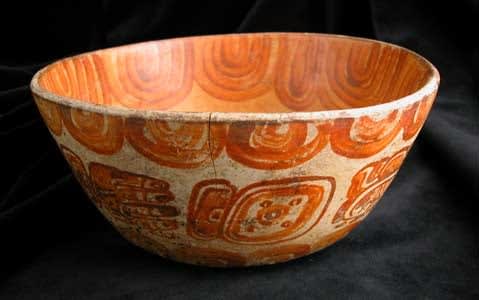Mayan Polychrome Bowl, 500 CE - 900 CE
Terracotta
8.25 x 3.625
PF.6009
Further images
The Ancient Maya were undoubtedly the masters of ceramics in Mesoamerica. Few cultures anywhere in the world can compare to the level of sophisticated artistry of the paintings and elegant...
The Ancient Maya were undoubtedly the masters of ceramics in Mesoamerica. Few cultures anywhere in the world can compare to the level of sophisticated artistry of the paintings and elegant forms of the pottery that the Maya achieved. However, when one considers that all Mayan vessels were created without the aid of a potter’s wheel, their achievement becomes even that much more stunning. This vessel is a perfect example of Mayan ceramics. When we hold the bowl in our hands, we feel the subtle bumps and indentations that are the telltale signs of handcraftsmanship. Typical Mayan motifs decorate the vessel, rendered in a lively, painterly fashion. A row of glyphs graces half of the exterior, framed on the top and bottom by a series of concentric arches. The other half is filled by an abstract pattern of brown and black lines that recalls the meander motif. A flower-like design adorns the bottom of the bowl, surrounded by snake-like squiggles, while the upper rim of the interior has been decorated with more concentric arches as seen on the exterior. While this vessel appears to be a beautiful example of functional pottery, there was a greater purpose for this bowl than the transportation and containment of precious liquids. Discovered in a tomb, buried alongside a deceased ruler or high-ranking dignitary, this vase was as essential in the afterlife as it was in our world.







